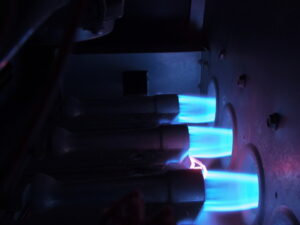Natural gas furnaces are widely favored for home heating in the United States, with almost half of homeowners opting for this efficient system to ensure warmth and comfort. While these furnaces come equipped with safety features to mitigate risks, it’s crucial to have your gas furnace maintained every year so technicians can be vigilant about catching any potential safety issues.
One such concern, though infrequent, is the possibility of a cracked heat exchanger, which can pose serious hazards, including the leakage of carbon monoxide gas. Recognizing the indicators of a compromised heat exchanger is essential for prompt furnace repair. Let’s go over why a cracked heat exchanger in a furnace is a safety hazard along with the signs that this could be happening with your furnace.
What Is a Furnace Heat Exchanger?
The heat exchanger serves as a container for hot combustion gas from the burners, transferring heat to the surrounding air before releasing exhaust outside. Over time, wear and tear, exacerbated by factors like short cycling, can lead to cracks, particularly in older furnaces that haven’t been maintained regularly.
A heat exchanger is susceptible to deterioration due to the expansion and contraction of its metal compartments during the heating process in your home. The repeated cycling, particularly short cycling, imposes significant stress on the furnace. Over time, this stress, combined with corrosion, can lead to the development of cracks in the heat exchanger.
Signs of a Cracked Heat Exchanger
Identifying symptoms of a cracked heat exchanger isn’t always straightforward, as these microscopic cracks may not be visible to the naked eye. However, signs such as triggered carbon monoxide detectors, physical symptoms of carbon monoxide poisoning, unusual odors, lack of heat production, exterior corrosion, unusual noises, soot accumulation, and changes in the pilot light color can indicate a problem.
Regular furnace maintenance is vital to prevent such issues, as it offers an opportunity for technicians to detect and address potential hazards early, regardless of the furnace’s age. Annual maintenance remains a key preventive measure to ensure the continued safety and efficiency of gas furnace systems.
Here are some signs that something is potentially wrong with your furnace’s heat exchanger.
- Your carbon monoxide alarms are sounding.
- Someone in your household is displaying symptoms of carbon monoxide poisoning, such as nausea, tiredness, vomiting, and flu-like symptoms.
- You detect unpleasant odors in your home, such as the scent of sulfur, formaldehyde, or rotten eggs.
- Your furnace fails to generate heat.
- Exterior cracks or corrosion on your furnace suggest internal corrosion.
- You hear repetitive clicking sounds following the blower’s shutdown, or other unusual noises like rattling, popping, and banging.
- You observe a buildup of soot.
- The pilot light appears yellow or orange instead of its normal blue hue.
At Roberts Heating & Air Conditioning, Inc., homeowners have been relying on our services for over 4 decades, and we understand the unique requirements you may have when it comes to properly and safely heating your home.
Contact Roberts Heating & Air Conditioning, Inc. today to schedule your furnace repairs in Northbrook, IL.


